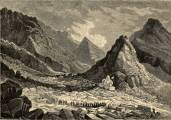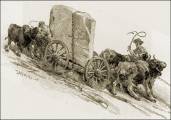(Please note: This book is available for reading and downloading to your computer on the Google Book Search - Full View Books web site.)
Igneous Rocks (Chiefly Granites) and Gneisses.
Southwestern Area - Missouri, pp. 158-159.
“The igneous rocks lie chiefly in the St. Francois Mountains area, and consist mainly of granite and rhyolite.
“The major portion of the granite is in an area of about 110 square miles, lying west and southwest of Knob Lick, but aside from this there are a number of small areas clustered around Fredericktown, Madison County.
“The granite, which is a quartz-orthoclase-biotite rock, with subordinate hornblende, varies from a light gray, though different shades of reddish pink to brownish red, but the prevailing color is some shade of red.
“Much of it is of porphyritic texture, but still there is much variation from this. The Cornwall granite is very coarse, that of Graniteville a little less so, while the Knob Lick is medium grained.
“The rhyolite varies from many shades of dark red and wine color, to dark brown and black. It is not popular as a building stone, for, although it takes a good polish, it is badly broken by joints.
“Graniteville. The largest and most important quarries in the state are here. The stone is a red granite of pleasing red color, medium to coarse grained, and takes a good durable polish. It is, therefore, much used for constructional and monumental work.
“Blocks of large size can be extracted, and columns 16 feet long and 2 feet 6 inches in diameter have been obtained.
“Examples: - Merchants Bridge and Terminal Railway, and Mercantile Library, St. Louis, Mo.; Thos. Allen’s Monument, polished monolith of 42 tons weight, Pittsfield, Mass.; Post Offices, St. Louis, Mo.; and Cincinnati, Ohio; Whitney National Bank, New Orleans, La.; columns of Flood Building, San Francisco.
“Knob Lick. The granite of this district is of a gray to grayish red color, and finer grained than that of Graniteville. Knots are not uncommon in it and may cause trouble. Much quarrying for paving blocks was done here in former years.”
Sandstones.
Central States.- Missouri, pp. 176.
“The most important sandstone quarries in the state are located at Warrensburg and Miami. The formation supplies large blocks of sandstone of either blue or white color. Some of the stone is reedy and hence care is required in selecting it. The stone hardens on exposure to the atmosphere.”
Limestones and Marbles, pp. 196.
“Limestone formations are known to underlie an extensive area in Missouri, probably two-thirds of them belonging to the Lower Carboniferous formation.
“Of these the Burlington formation is the most important, since it supplies the greatest amount of cut and sawed stone of any of the formations in the state.
“This stone, which is extensively quarried around Carthage as well as Phenix an Hannibal, is of a uniform light, almost white color, and is strong and durable. It can, moreover, be quarried in blocks of large dimensions.
“The stone is more difficult to cut and dress than Bedford stone, but is lighter and more uniformly colored, also stronger and denser.
“It takes a good polish and has been much used in monumental work, but one difficulty has been the obtaining of large pieces free from suture joints. Flint nodules are found at definite horizons in the formation, and have to be avoided.
“Examples: - Carnegie Library, Joplin, Mo.; Stillwell Hotel, Pittsburgh, Kans.; Public Library, Kansas City, Mo.; Ex-Confederate Monument, Ft. Smith, Ark.
“While this is the most important limestone quarried in the state, there are others which are worked to a minor extent.
“In southern Missouri the dolomites of the Cambro-Ordovician formation are extensively used for building. This includes the so-called cotton rock quarried around Jefferson City.
“In southern Missouri there are also finer-grained limestones, somewhat resembling marble.
“Around Stee Genevieve the Trenton limestone supplies a good building material, but the same formation around St. Louis is soft and undesirable.
“Near St. Louis, the St. Louis limestone is extensively quarried for rough masonry.”
Marble in Missouri, pp. 223.
“This state does not produce any true marble, but the dense, light cream white limestone quarried near Carthage is often classed as such in the trade. This stone takes a polish and might be classed as a monotone marble.
“Examples. - Denkman Memorial Library at Rock Island, Ill.; Court House, Butler, Mo.; for interior work of Masonic Temple, Wichita, Kan.”


